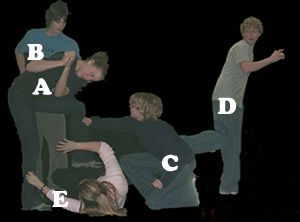|
|
 
Unit
4- Script and Play Analysis
Module
3 - Blocking
Lesson
1 - Making
Pictures and
Levels
Introduction:
Blocking
is the controlled stage movement that actors repeat each time
they do a scene. If you are supposed to cross the stage and go
to the door on the line "What, you miserable frog?",
you have a blocked movement. As you are doing this movement, the
other actors have movements they must complete. Collectively these
movements are called blocking.
This
lesson is designed to help students understand the concept that
blocking makes pictures.
Objectives:
- to become comfortable in blocking improvised or scripted scenes
- to practice leadership in small and large groups
- to accept leadership of others in small and large groups
- initiate ideas for drama experiences
Resources:
(pdf's)
Blocking Exercise I, Blocking
Exercise II, Internet connection for one hour
CELs:
IL, TL, Com
Components:
Creative/Productive
Characteristics
of good blocking
|
If
frozen at any moment, the blocking forms a beautiful picture.
The blocking is consistent with the characters.
The blocking has good variety.
The blocking uses the whole stage.
Each picture employs many levels (sitting, standing, laying).
Eyes are used to create a focus point or person.
|
Activities:
Activity
1 - Blocking Check:
The pictures below show how blocked scenes show emotion, even
when frozen. We can see the relationship between the characters
or see events about to happen. The pictures are more interesting
if we see many things going on, or more powerful if one important
thing is happening. Have your students view the pictures and do
the questions as an introductory set. (5 min.)
 |
Picture
1
The
movement that is occurring in the scene beside is clear,
even when it is frozen. D is clearly fleeing the
scene, just as A is clearly hitting E. We
can see relationships in how the characters move to protect
each other (C protects E) or look on indifferently.
Photograph
by Kurtis Hamel.
|
|
Picture
2
The
picture above was more interesting because there were many
things happening. This picture is more powerful because
the focal point of the activity is very clear. A
is the focus of this scene and the "eye" of the
audience knows to follow A.
Photograph
by Kurtis Hamel.
|
 |
|
|
|
1.
Who has the most power in Picture 1?
2.
Rank the characters in Picture 2 in order by the power
that they have.
|
|
Activity
Two - Internet Search
 |
Using
the Internet, students should find pictures of scenes from
plays. They should look for pictures that fit into 3 categories:
stage pictures that show power, stage pictures that show
variety, and stage pictures that show movement.
The
pictures should be copied into an application that supports
graphics with text underneath. Each of the three categories
needs to contain a minimum of 3 photos with written explanations
of what the pictures show and why. The purpose is to demonstrate
understanding of how blocking functions as a series of pictures.
(60 min.)
Restate
the following warning to your students verbally: "Remember
that all pictures you use must be in the public domain (copyright
free) and should have the URL of the site you copied them
from listed under the photo."
|
|
How
do I
copy an image
from the net?
|
Activity
3 - Blocking a scene:
(Extra
Blocking Practice if you feel the class could use it:
(pdf's) Blocking Exercise
I, Blocking Exercise II)
Students should break into groups of two to five and develop a
dramatic scene without words. Through blocked movement, they must
demonstrate who has the power in the scene and why. The main conflict
and each character's objective must also be demonstrated through
movement. Groups should present their scenes for the class. Following
each scene, the class should discuss what has worked and what
has not. (30 min.)
Instructional
Strategies: role playing, computer assisted instruction
Evaluation:
The Internet blocking pictures should be marked out of /27. One
mark would be given for each picture (nine total), each explanation
(nine total) and each correct placement in a category (nine total).
Blocked scenes should be discussed as a class (informal peer-evaluation)
On-line
Activity Alternatives: Activity One is already presented on
line. Activity Two could be worked on by groups of two or more
in their home schools.
Next
Lesson / Student Lesson
/ Previous Lesson
|
|
|










